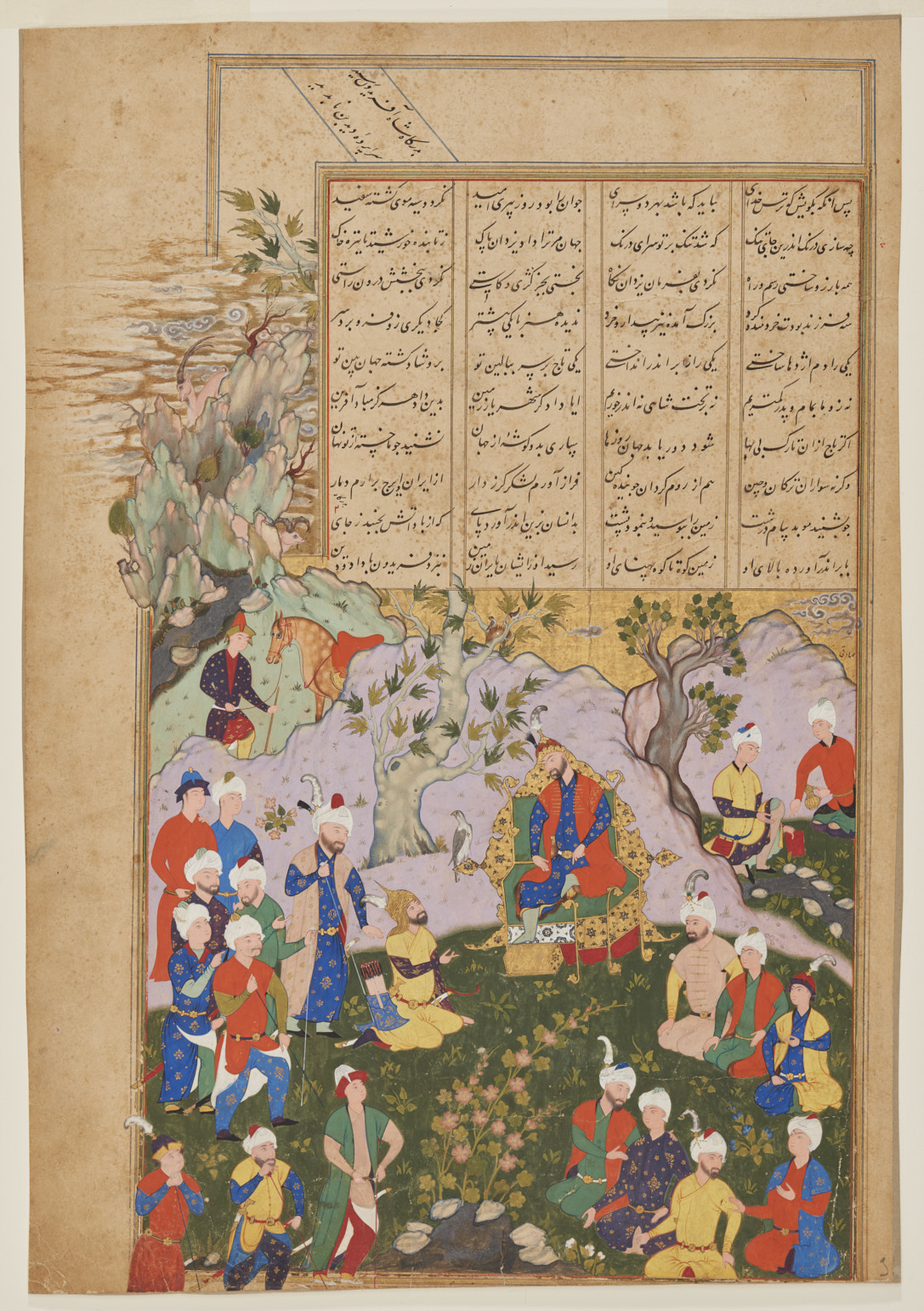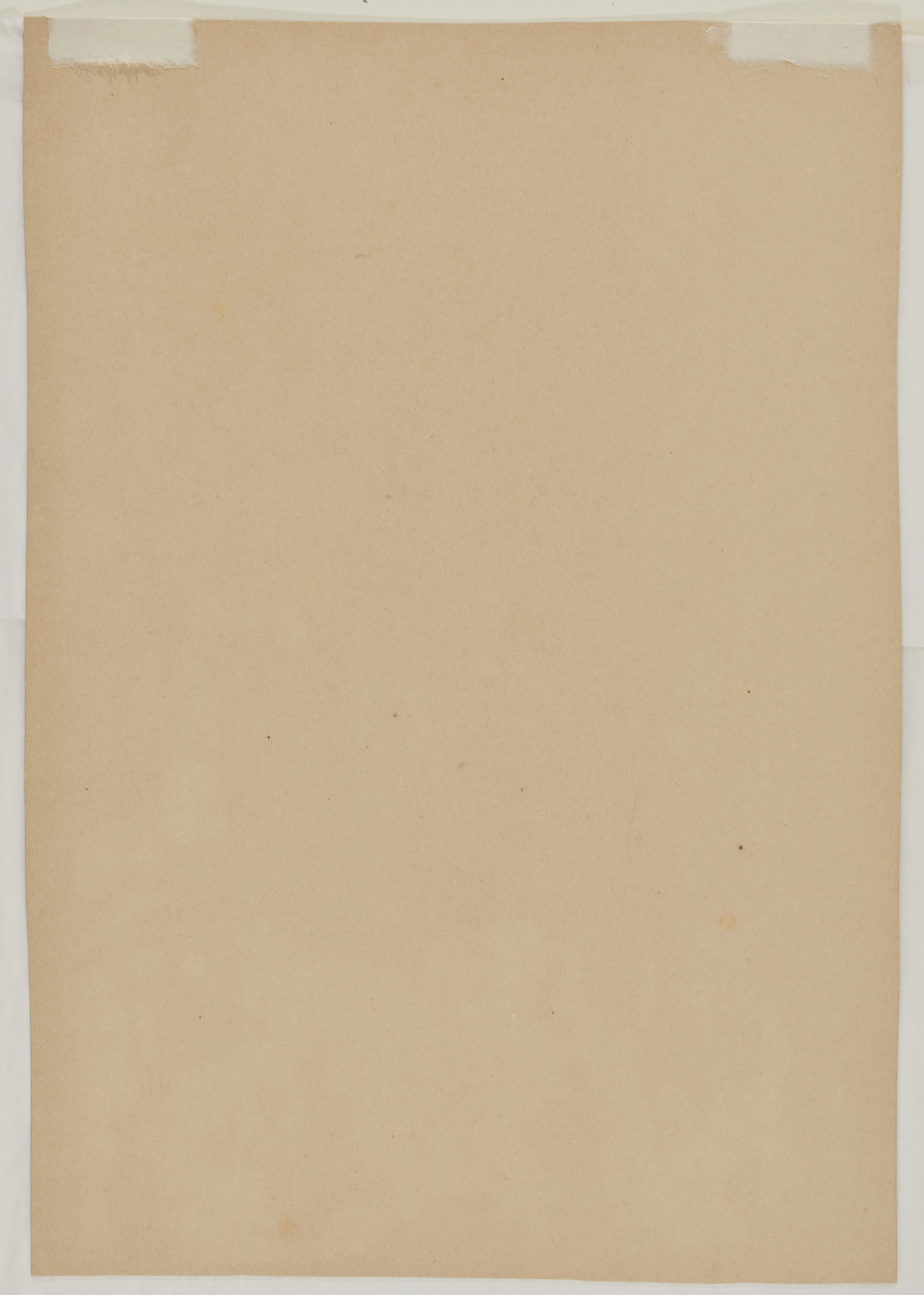Click on the image to zoom
Faridun with the envoys of Salm and Tur
Folio from the Shahnameh (Book of Kings) of Shah Ismail II
- Accession Number:AKM99
- Place:Iran, Qazvin
- Dimensions:43 x 29.9 cm
- Date:1576–77
- Materials and Technique:opaque watercolour, gold, silver and ink on paper
The miniature painting “Faridun with the envoys of Salm and Tur” is from a dispersed illustrated manuscript of the Shahnameh (Book of Kings), completed by the Persian poet Firdausi ca. 1010. Shah Ismail II (r. 1576–77) [1] commissioned the manuscript, following the examples of his grandfather, Ismail I, and father Shah Tahmasp, both of whom showed interest in Firdausi’s epic at one time during their reigns. Ismail II’s Shahnameh can be seen as a link in the chain of royal copies of the Book of Kings, after Shah Tahmasp’s spectacular manuscript and forming a bridge to the next period of royal patronage of the epic under Shah ‘Abbas (1587–1629). The manuscript was left unfinished upon Ismail II’s death. However, for a brief period, Ismail II’s atelier employed a number of artists who contributed to the illustration of the Shahnameh, including Siyavush, Sadiqi Beg, Naqdi, Murad Dailami and Mihrab. These artists did not sign their work, and attributions were probably made by the contemporary royal librarian. In this painting, beneath the chinoiserie cloud in the top right-hand corner of the sky can be seen the name Sadiqi Beg (d. 1610?), a major artist of the period.
See AKM70 for an introduction to the Shahnameh (Book of Kings) of Shah Ismail II.
Further Reading
The painting illustrates the arrival at the court of Faridun of an envoy from two of his sons, Salm (to whom he had assigned the western reaches of the realm) and Tur (who received the East—that is, Turkestan or the lands of the Turks). The messenger, described as a mobad or priest (though not depicted this way), was to represent the brothers’ anger at this division. They resented the fact that their younger brother Iraj received the choice part of the world (Iran), and they threatened invasion if Faridun failed to alter his decision.[2]
The scene, which has few precedents, is essentially a parley or meeting between people representing two opposing sides of a dispute. Interestingly, previous examples are both found in significant commissioned copies of the Shahnameh: the “Big Head” manuscript, perhaps made for the young Shah Ismail I in Gilan in the 1490s, and the luxurious copy made for Ismail II’s father, Shah Tahmasp in the 1530s. Both of these illustrate the description of Faridun’s throne as surrounded by lions, leopards and elephants, which is narrated a little later in the text.[3]
The verse immediately before the painting is not found in the standard editions of the epic: “He (the mobad) came from them (the brothers) with justice and faith to Faridun, in the land of Iran.” The verse written at an angle in the top margin was omitted after the second verse in row 9, where the small red sign indicates it should be inserted. The folio appears to have been chopped off along the bottom. Such damage is a good example of the destructive way in which the Belgian art dealer Georges Demotte broke up the manuscript following its exhibition, intact, in Paris in 1912.[4]
The format of the page is similar to that of “Zahhak consults the physicians” (AKM71). Here, however, the painting fits around the text, whereas in the previous case, it is as if the text were superimposed on the picture. The difference in painting technique is marked, despite the ostensibly similar composition of the rocky outcrop, tree, and stream in the left-hand margin. The figures are smaller and more numerous, their gestures more lively.
Sadiqi Beg was starting his career at this time, a student of the celebrated Muzaffar ‘Ali (d. 1576). Thanks to his own writings, we are better informed about Sadiqi than many other Safavid artists; his chequered and eventful career at the court of Shah ‘Abbas ended in 1610. Seven paintings in the Shah Ismail II Shahnameh are attributed to him, and a total of three are held in the Aga Khan Museum Collection (AKM99, AKM72, AKM100).[5]
The Aga Khan Museum Collection has eight folios from the Shahnameh (Book of Kings) of Shah Ismail II, see AKM70, AKM71, AKM72, AKM99, AKM100, AKM101, AKM102, AKM103.
— Charles Melville
Notes
[1] Shah Ismail II was the third ruler of the Safavid dynasty (1501–1722). Reuniting the eastern and western provinces of Iran, the Safavids introduced Shiite Islam as the official state religion. Ismail II, son of Tahmasp (r. 1524–76), seems to have been inclined to return to Sunnism, but in this and his artistic patronage he was perhaps simply seeking to distance himself from his father’s regime. He was murdered after ruling for 18 months.
[2] See for the episode, and the text here, Abbas Amanat, “Divided patrimony, tree of royal power, and fruit of vengeance: Political paradigms and Iranian self-image in the story of Faridun in the Shahnama,” in Shahnama Studies I, ed. Charles Melville, Cambridge: Centre for Middle Eastern and Islamic studies, 2006, 49-70, esp. p. 58. Shahnameh, ed. by Jules Mohl, “Faridun,” verses 345–364; ed. by Djalal Khaleghi-Motlagh, “Faridun,” verses 323–42.
[3] The “Big Head” manuscript, perhaps made for the young Shah Ismail I in Gilan, Istanbul, Turk ve Islam Eserleri Muzesi, MS 1978, fol. 29v; Shah Tahmasp Shahnama, Tehran, Museum of Contemporary Art, fol. 44v. Another version of the same scene was made later, for the Shahnama commissioned by Shah ‘Abbas, Dublin, Chester Beatty Library, Per. 277.07b.
[4] Robinson, “Ismail II’s copy,” 7.
[5] Welch, Artists for the Shah, 41–99; Robinson, “Isma‘il II’s copy of the Shahnama,” 6. For this painting, Sheila R. Canby, Princes, Poets & Paladins, 58–59 and pl. 33; Welch, Artists, 80–85 and pl. 5.
References with ISBN or DOI
Amanat, Abbas. “Divided patrimony, tree of royal power, and fruit of vengeance: Political paradigms and Iranian self-image in the story of Faridun in the Shahnama,” in Shahnama Studies I, ed. Charles Melville, Cambridge: Centre for Middle Eastern and Islamic studies, 2006, 49–70.
Canby, Sheila R. Princes, Poets & Paladins. Islamic and Indian Paintings from the Collection of Prince and Princess Sadruddin Aga Khan. London: British Museum, 1998. ISBN: 9780714114835.
Khaleghi-Motlagh, Djalal, ed. Shahnameh. Costa Mesa, CA: Mazda Publishers in association with Bibliotheca Persica, 1992.
Mohl, Jules, ed. Shahnameh (Livre des rois). Paris: Impr. Nationale, 1876–78.
Robinson, BW. “Isma‘il II’s copy of the Shahnama,” Iran 14 (1976), 1–8; reprinted in B.W. Robinson, Studies in Persian Art, Vol. II. London: Pindar Press, 1993, 290–305. ISBN: 9780907132431.
Welch, Anthony. Artists for the Shah. Late Sixteenth-Century Painting at the Imperial Court of Iran. New Haven and London: Yale University Press, 1976. ISBN: 9780300019155.
--- and Stuart Cary Welch, Arts of the Islamic Book – the Collection of Prince Sadruddin Aga Khan. Ithaca & London: Cornell University Press, 1982. ISBN: 9780801415487.
Note: This online resource is reviewed and updated on an ongoing basis. We are committed to improving this information and will revise and update knowledge about this object as it becomes available.




